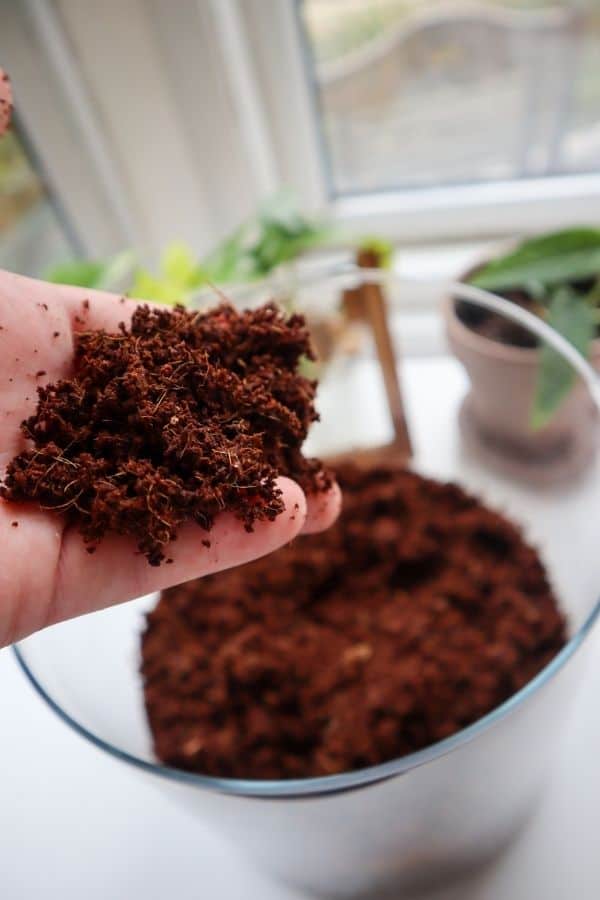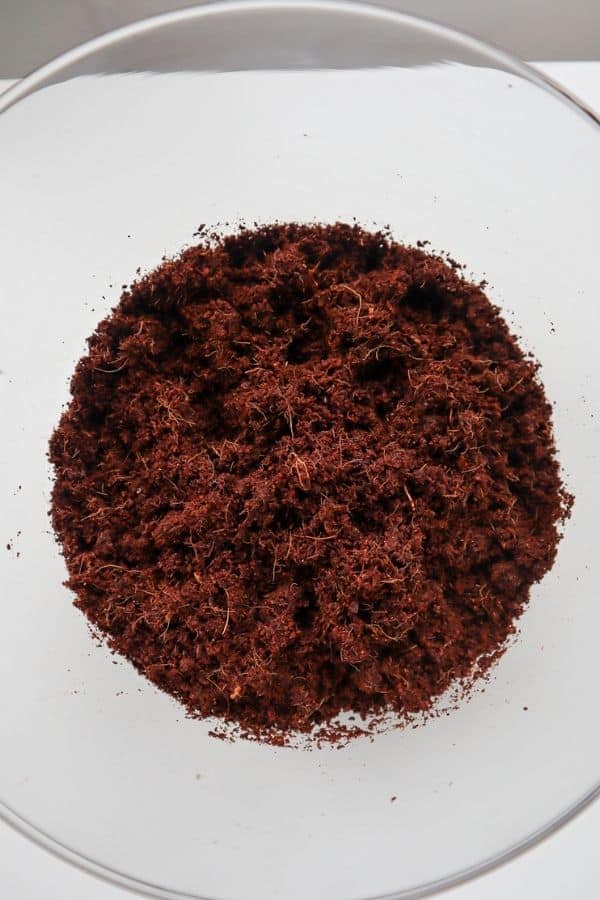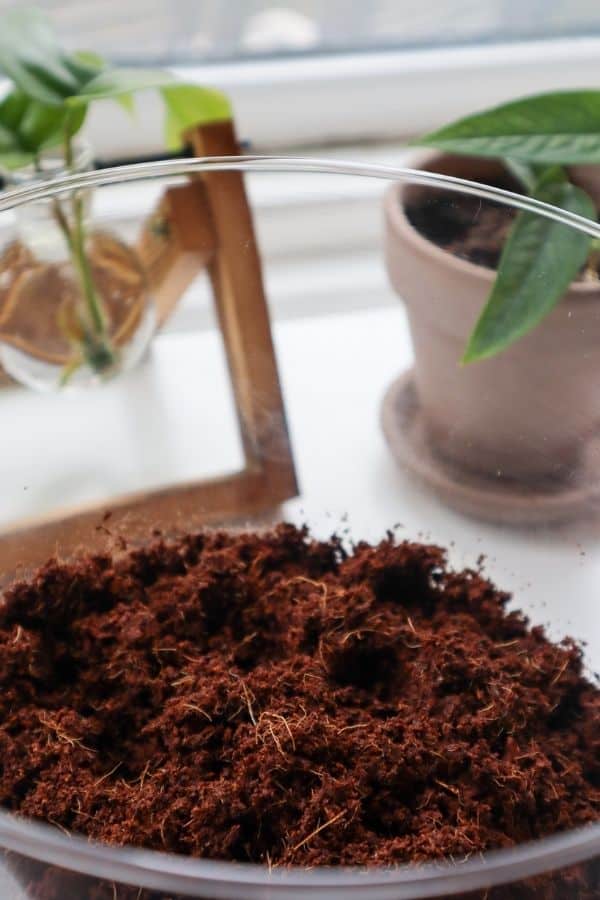If you’re into terrariums, houseplants, hydroponics, or gardening, chances are you’ve heard of coco coir before today. It’s an incredibly popular substrate medium, and for good reason!
But, not everyone knows why, what to look out for when buying, or how it is best used in practice.
This will be the definitive guide to coco coir.
Let’s get our hands dirty, shall we?

Terrarium Tribe is reader-supported. When you purchase through links on our site, we may earn an affiliate commission (at no further cost to you). 💜
What is Coconut Coir?
Fundamentally, coconut coir (pronounced kwoy-uh) is a composition of elements harvested from a coconut.
It’s an increasingly popular medium for hydroponic growers, houseplant parents, and indeed, terrarium enthusiasts.
The medium is known for its ability to simultaneously store water, allow proper drainage, and help in delivering nutrients into a root system.
Pretty handy, right?
Coco coir itself can be made up of anything in between the shell of the coconut and the seed’s outer coating.
In fact, the long fibrous material extracted from these coconut husks has long had a wide range of applications; from brushes and baskets to mattress stuffing.
It is a truly versatile material.
However, until the 1940s, the shorter fibers and ‘dust’ from the husk were considered waste products and added to landfills.
It was supposedly not until much later in the 20th century that coco coir started being taken seriously as a growing medium.
It’s safe to say that’s changed now, and you’re about to learn why.

What is Coco Coir Made from?
Coco coir isn’t just a single element material – there are three predominant sub-types / components.
All of which can be used separately, but together create the crème de la coconut of growing mediums.
1. Coco Pith
Coco pith or ‘dust’ is a finely ground mixture that looks most the part of a typical potting substrate.
It has a rich brown colour and somewhat resembles peat moss. It has roughly the same properties too, as its primary function is water absorption.
This component is made up of millions of capillaries that act like micro-sponges, meaning coco pith can retain up to nine times its weight in water!
In fact, it’s such an adept water retainer it’s imperative to combine it with other elements to facilitate proper drainage.
2. Coco Fibre
The fibrous strands of the coconut husk are excellent aerators.
Coco pith, left to its own spongy devices, will create a wet and dense substrate.
While coco coir is naturally resistant to pathogens (more on this later) the fibres perform a much-needed function: allowing oxygen to pass through the medium and reach the root zone.
Oxygenated roots encourage a plant to respire so that it may continue to grow healthily.
3. Coco chips
The third and final ingredient in our holy coco-trinity is the humble chip.
The chips made from the husk enact a hybrid function of the fibre and pith elements.
While of a size appropriate to aerate the soil (and resist compaction over time) and encourage drainage, they can also store water.
The Pros and Cons of Using Coco Coir
Now, it’s important to realize not all coco coir is created equal.
The process by which it is extracted, stored, and refined will determine just how beneficial the medium will be.
But before we get into that – let’s look at exactly what those benefits are and consider when a coir substrate might not be the most appropriate choice.
Pros
1. Coir combines aeration, drainage, and water retention.
The three primary components of coco coir create the perfect environment for a large majority of plants commonly used in gardening, as houseplants, and within terrariums.
So often is the requirement ‘moist, well-drained soil’.
With pith retaining water, fibers aerating your soil, and chips providing solid drainage – you’ve got a solid base for your substrate.
Depending on the mix you’ve purchased, however, your coir may not have as much of one component as you might need.
It may be lacking in chips, for example, which are easily substituted with orchid bark.
2. Coco coir is an incredibly stable and mold-resistant material.
All thanks to naturally high concentrations of lignin. This organic polymer encourages the development of valuable micro-organisms and subsequently discourages decomposition.
This adds to the sustainable nature of the substrate, more of which I’ll touch on later.
It has also been discovered that certain soil-borne pathogens can be subdued if a substrate is amended with coco coir.
This inhibition of damaging mycelial growth is a particularly tantalizing trait for terrarium artists – as mold is so often cited as an issue.
3. Nutrient storage and delivery.
Earlier, I briefly mentioned coco coir’s lesser-known potential to store and release nutrients unto the roots of a plant.
Groups of nutrients and cations can be stored within a growing medium. The more cations that can be stored, the higher the medium’s cation exchange capacity, or CEC.
Coco coir has a high cation exchange capacity and so has the ability to store nutrients quite effectively, but it is a double-edged sword.
If refined improperly, coco coir may release an excess of sodium and potassium while preventing the release of calcium and magnesium – essential nutrients to most flora.
The result of a properly treated substrate is healthier, nutrient-rich plants (more on this later).
4. Coconut coir is highly sustainable.
Peat moss is a notoriously unsustainable medium, though still to this day recommended constantly to terrarium and horticultural enthusiasts.
Whereas the peat from bogs takes decades to replenish, if not centuries, coconuts can be quickly and sustainably farmed.
The reusability of the coir substrate only adds to its appeal. I’ll talk a little bit more about coir as a peat moss substitute later on.

Cons
1. Potentially high salt-water content.
The excess of sodium chloride can be a problem if the coco coir is soaked in salt water and not subsequently rinsed with fresh water.
When dissolved in water, the sodium and chloride elements separate. Chloride ions are easily absorbed by roots and will eventually reach a toxic level.
Sodium reacts on plant tissue via osmosis, whereby water is diverted away from plant tissue.
Not what we (or our moisture-loving plants) want!
2. Nitrogen draw-down.
One of coco coir’s core strengths is its sustainability and reusability.
Like all things, however, it will eventually break down over time.
The effect of a build of carbon within the substrate will slowly encourage decomposition, which will encourage nitrogen to bind to the substrate so that it is no longer available to your plants.
Though, this is a relatively uncommon occurrence and can be postponed with a well-aerated substrate combined with other components like sphagnum moss and leca – which will further prevent decomposition.
3. Coir contains no nutrients
As an inert material, coco coir brings nothing to the table in terms of plant nutrients.
This makes it somewhat limited when used 100% on its own as a growth medium – or at least without fertilizer supplementation – but that’s why it’s almost always used as a base in substrate mix.
Using Coco Coir as a Substrate Base (and Inside a Terrarium)
The properties of coco coir make it a near-perfect medium for use with tropical plants.
- Drainage? Check.
- Water retention? Check.
- Aeration? Check.
- High CEC? Check.
All that’s missing is a rich supply of nutrients and organic matter to begin with.
Though, one wouldn’t tend to use pure coco coir for anyway. It is best combined with other materials that, when combined, create a Voltron-like substrate.

Let’s take a look at a classic terrarium mix, the ABG. Coined by and named after the Atlanta Botanical Gardens, this mix has become a household staple within the terrarium and vivarium communities.
Though it has been fiddled with, altered, and amended by many throughout the past decade or so, the basic functionality remains the same.
- Sphagnum Moss – 1 part
- Tree Fern Fibre – 2 parts
- Orchid Bark – 1 part
- Peat Moss – 1 part
- Charcoal – 1 part
But woah now sailor, keep your hat on.
I know what you’re thinking. What’s that gosh darn peat moss doing there? Well, don’t you worry.
Let’s do a little editing:
- Sphagnum moss – 1 part
- Coco Coir – 2 parts
- Orchid Bark – 1 part
- Activated Charcoal –1 part
Peat moss and tree fern fibre (another unsustainable choice, by the way!) have now been substituted for the big guns; coco coir.
The addition of orchid bark solidifies aeration and drainage and prevents compaction over time.
Activated charcoal has such a high surface area it can absorb and bind high volumes of potentially harmful chemicals, keeping your plants safe.
I like to add worm castings too, as they release nutrients slowly over time – making your job of keeping the terrarium healthy a little easier. You can grab a bag here.
Other Uses
Aside from terrariums, coco coir, of course, has a whole roster of other uses:
1. As a component within potting mixes, alongside similar components as in our terrarium mix.
2. As a hydroponic growing medium, supplemented with fertilisers and/or root hormones (the high CEC comes into play here)
3. An amendment to garden soils to increase drainage and aeration – often to balance the acidity of a clay-based soil or increase water retention in a sandier mix.
How Is Coco Coir Made? (And Why It’s Important)
Alright. I feel like I’ve been building up to this.
I’ve maybe made it seem as if there is some sacred, magical ritual that must be performed onto a coconut so that it may be imbued with the spirits of its ancestors – and become fertile for centuries to come.
The reality, fortunately, is much simpler. Unfortunately, it’s also much less exciting.
Let’s say no more of fertility rituals and get right into it.
The Process
Once accumulated, coconut husks are softened in water.
Now, this bit is important.
Depending on the farm, the husks will either be soaked in fresh or saltwater. If in tidal waters, an excess of salt will be absorbed that needs to be rinsed out at a later stage.
This flushing of sodium is a stage that, if skipped, could be catastrophic for your plants.
The coir is then separated from the husks and left to sun-dry for an extensive period. This could be up to and even sometimes beyond a year.
Piles of the coir are then taken from storage and formed into bales so that they may then mature over time. The longer this maturation process continues, the finer the quality of the final product.
It is at this stage some manufacturers will opt to use chemicals to sterilise the coco coir.
While adept at eliminating pathogens, these chemicals could be harmful to your plants by the time the product reaches your doorstep.
A preferable alternative to chemical sterilisation is to steam the mix.
The best manufacturers will ‘wash and buffer’ their substrate. This is to remove excess sodium built up from seawater and prevent the binding of nutrients such as calcium and magnesium.
The coco substrate is washed thoroughly with fresh / distilled water and then pre-treated with fertiliser to encourage the cation exchange capacity.
Make sure to check the labels and/or do a little online research on your selected suppliers to make sure you’re getting the quality you deserve.
Where to Buy Coconut Coir
Coconut coir is sold in several forms, mostly dried and compressed into different shapes and products.
There’s no huge difference in quality between types – it’s more the source that matters – but some can be considered more convenient than others depending on your needs.
- Loose – bags of pure horticultural coco coir are available freely online, and they can represent all three components of the pith, chips and fibres.
- Bricks – here the coir is dried and compressed into a large block. It will need rehydrating before use, but one block can really go a long way – It’ll get much bigger.
- Plugs – kind of like tiny round bricks, they tend to be sold for a specific purpose (e.g., for planting seeds). If you only need a small amount of coir, once rehydrated (and fluffed up) these can often provide enough material for a small project.
👉Shop loose coco coir on the Terrarium Tribe online store.
Coco Coir as an Alternative to Peat Moss
I touched on this a little already, but I would like to expand on how important it is to consider coco coir as an alternative to peat moss.
Peat bogs are, at least within the UK, the largest land-based carbon sinks. In this day and age of ever-rising levels of carbon, it could not be more crucial that we protect these spaces.
They’re doing us a massive favour, and they are home to a plethora of wildlife and can protect against flooding.
Peat bogs are formed over decades and centuries, so when we extract the moss so regularly, we are invariably destroying an ecosystem.
And for what? There are alternatives, it isn’t necessary.
The problem has become so prevalent that the UK is implementing a carpet ban on the sale of peat moss.
This will allow peat bogs to rejuvenate and prevent their destruction from releasing even more carbon into our atmosphere.
Enter coco coir.
Coconut trees absorb carbon and produce an annual harvest. The coir has strong longevity and can be reused multiple times over.
As a by-product of harvest, you’re saving coir from being added to landfills, where it can take decades or longer to break down.
Additionally, it has been found that seedlings actually germinate earlier in a coir substrate than in peat.
So, for peat’s sake, switch to coir.
Over to You
This has been and is THE definitive guide to coco coir.
Tell me, is it a substrate you’ve used before? How has it affected your terrariums and – is there anything crucial I missed?
Let me know down below!

Good article Joe. So glad I found it! Enjoyed reading the ABG mix article also, thanks for the link. If u missed anything, I wouldn’t know. About to start my 1st terrarium build so I’m reading everything I can about it.